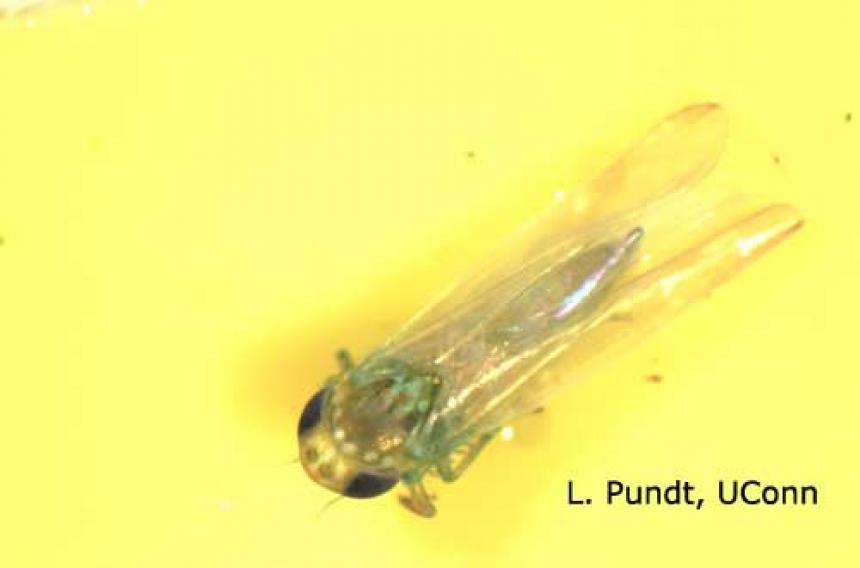This is the immature stage of the potato leafhopper. Note the white eyes and yellowish-green color of the body.The immature stage, or nymphs, are 1/16 - 1/8 inch long and are wingless. Nymphs quickly move forward, backwards and sideways.
Adult potato leafhoppers are approximately 1/8 inch long, yellowish-green, wedge shaped insects and may be recognized by the 6 white spots on their blunt head. Yellow sticky cards are often helpful to catch the fast moving adults in order to determine which type of leafhopper is present.
Leafhoppers are found on many different out-door grown perennials and sometimes garden mums. Of the many species of leafhoppers, only the potato leafhopper and aster leafhopper are most likely pests on ornamentals in New England. Both adult species have slender bodies and wings that are held roof-like over their body. Leafhoppers jump or fly when disturbed and can quickly move sideways, backwards or forwards. The nymphs resemble adults but lack wings. They have piercing-sucking mouthparts and feed on plant sap, causing yellowing, stunting and loss of vigor.
The potato leafhopper injects a toxin as it feeds so leaves may develop a v-shaped brown, edge burn at the tip known as "hopperburn". This injury may be confused with leaf scorch especially on drought-sensitive Astilbe. Plants may also be stunted with distorted new growth. The aster leafhopper transmits the pathogen that causes aster yellows. Other species of leafhoppers may not inject a toxin or transmit diseases as they feed so control may not always be necessary.
Scouting: Brush the leaves of plants with your hand. Small light yellow-green potato leafhoppers dart around and fly up from foliage when disturbed. Tap the foliage over a yellow sticky card or briefly place a sticky card among the plants to catch adults. Once you see adults, look closely at several leaves for nymphs. Nymphs are small, narrow light green wedge shaped insects that move very fast sideways, front and back. Look on the underside of leaves along the leaf vein for the young nymphs especially on Alcea, Astilbe and Dahlia.
Management: The potato leafhopper does not overwinter in New England. It migrates into New England in late April or early May from the south. There may be from 3 to 4 generations per year. Potato leafhoppers also feed on woody plants such as birches, maples and apples and vegetable crops.
Systemic insecticides such as neonicotinoids may be applied to prevent feeding damage when leafhoppers first appear. There are many other pesticides labeled for leafhoppers including azadirachtin, (MOA Group 18) pyrethroids (MOA Group 3), and Beauvaria bassiana(MOA Group M). Pesticides with limited residual will need to be reapplied with good coverage on the undersides of leaves. See the New England Guide for specific pesticides. Several predators, parasites and fungal pathogens attack the potato leafhopper, but effective biological control is seldom obtained.
